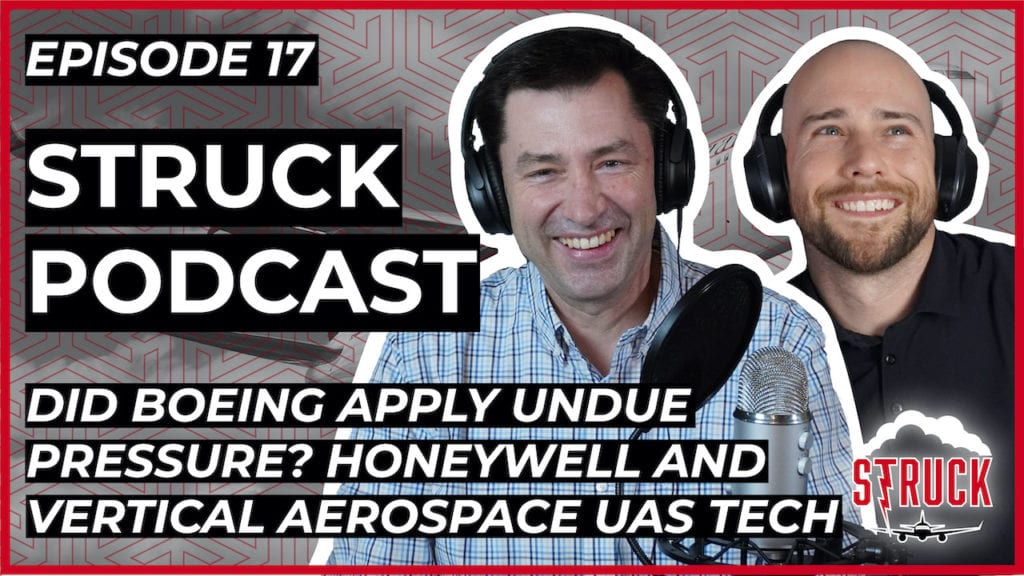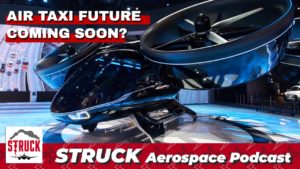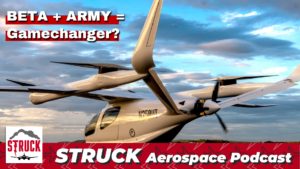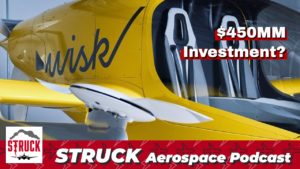Podcast: Play in new window | Download
In this episode, Allen and Dan discuss the idea of applying undue pressure to engineers as they moved to certification of the 737 MAX. They also explore some of Honeywell’s new UAS tech and their autonomous landing technology. Lastly, they cover Vertical Aerospace’s Seraph aircraft and discuss it’s path to market and potential engineering missteps.
Learn more about Weather Guard StrikeTape segmented lightning diverter strips. Follow the show on YouTube, Twitter, Linkedin and visit us on the web. Have a question we can answer on the show? Email us!
Full Transcript: Struck Podcast EP17 – Did Boeing Apply Undue Pressure re: 737 MAX? We discuss Honeywell’s UAS tech and Vertical Aerospace’s Seraph aircraft.
Dan: This episode is brought to you by Weather Guard Lightning Tech. At Weather Guard, we support design engineers and make lightning protection easy.
You’re listening to the Struck podcast. I’m Dan Blewett
Allen Hall: I’m Allen hall.
Dan: And here on Struck, we talk about everything. Aviation, aerospace engineering, and lightning protection.
Alright. Welcome back to another episode of the struck podcast, Allen. Well, it’s going on this week. Well,
Allen Hall: uh, Boeing’s under some pressure again, to get max deliveries go on. It sounds like the factories up and running, which is a good sign, but there’s a lot of FAA in department of transportation pressure for undue pressure on the delegated, uh, engineers that help sign off on the design, which is just another bad thing for Boeing to be going through.
So, you know, better week in terms of flights, did you notice that the number of people flying this week is up another couple of ticks? It’s not 20% up, but we’re in the low thirties look like in terms of number of flights versus last year, which is a good sign and alongside numbers still, still goes up and that’s a positive sign for the world economy and the U S economy and aviation overall.
And, uh, It also looks like the business community. The number of flights in the, on the business side is still pretty stable. It’s down, it’s down. I thought I heard 20 to 30% versus last year. That means we’re still in the 70 percentile range in terms of business flight and the lease market. That’s not bad in the lease market’s doing really well.
Uh, the partial ownership market, uh, I listened to a podcast this past week with Honda jet deal with HondaJet, a lease program from his that wasn’t a Honda. Own program, but as a Honda, they’re using Honda jets to shuttle people around. And it sounds like they were doing pretty well there. They had five airplanes in their fleet and we’re going to take delivery of another one here shortly.
And they’re going to add a total of 10 new ones. So to get to 15 odd digits in their fleet. And you have to have a pretty, uh, rosy economic forecast to bring hot to basically triple your size of your company. Joe’s airplane fleet. So I thought that was a, a good positive sign too. So some green shoots, right?
Dan: Yeah, a lot going on. Uh, so in today’s in today’s episode, we’re going to cover, uh, what Allen just mentioned. So belling and, uh, this undue pressure idea as far as some of their delegates, which is a really interesting, and, um, I know Alan has some pretty deep insight on this. We’re going to, in our engineering segment, we’re going to talk about Honeywell doing a bunch of stuff on the UAS and the urban air mobility side.
So they’ve got a couple of different pieces of new tech we’re gonna, we’re going to chat about. And then our third segment, we’re gonna cover, um, some vertical takeoff and landing, uh, news in the electric sector. So, uh, we’ll talk a little bit about vertical aerospace and their Saraf, uh, aircraft, which, uh, Honeywell is a, is a partner with that new development.
So interesting design. I know you’ve got some thoughts, so excited to get to that later, but let’s, let’s start first with, with Boeing. So this is something that you’ve had a lot of experience with being an FAA, der designated engineering representative. And so you felt this pressure of, Hey, we need you to sign off on this.
Um, So take us down this road of, of, of undue pressure on and what this all means.
Allen Hall: So the term undue pressure in relates to delegated, um, engineers or DTRS or unit members, or, uh, there’s different names from different place has been essentially their engineers that have. The authority to sign off on regulatory regulatory approval to say that that design complies with this particular regulation or regulations that it meets all the FAA requirements, therefore, uh, it can be approved.
That is a very high level of responsibility. Now in the real world, people have that der or unit member or airworthiness representative authority depends. Uh, just, just which is der is a generic term for all this as, as a der. You are also probably a person designing the system. So you’re one of, probably a, several people that helped him design the system, which you were ultimately hopefully later approved the show that it’s airworthy.
So you’re, you’re you have these engineers call it this two hats situation. My engineer hat, when I’m out there are design and stuff and I take the hat off and I put my FAA hat on and say, yup. Okay. It’s either good or it’s not good. And here’s the reason why. Human nature is a funny thing. So if you’re working for as a, as a der, a lot of, of just two levels of DTRS was to try to keep it simple there’s company DTRS that are employed by a company that can only work on behalf of the company to show compliance.
And then there’s sort of people like me or a consultant that YDS, who can work for anybody. Why there two levels? They’re not really sure. I’m sure the companies had something to do with that. So if I’m working for a company, a I’m an insurer company, but I’m also a der for company a I’m getting paid for both jobs by company.
A company writes my paycheck. And I’m at a bar and I’m a room or an office. We’ll have people who are my peers and my manager. I got to have a manager. Right. Cause I’m just a lowly engineer. Uh, I’m a manager. Uh, I have a manager who is, you know, roughly the same age. We all are. The kids probably go to the same schools.
There’s a, there’s a little community, a little click that develops there because you’re around each other all the time. And then you got this. Obligation of you need to get a design done to get it out the door and you should get this, uh, kind of a ying yang thing going on with management where management has to sign off and all the stuff, at least not until recently, there’s some.
Things about that, but basically a management could put pressure on DDRs to sign off on designs and der is you’d be able to push back and say, no, I don’t want to do that because here’s the reasons why, so you automatically create this sort of combative dynamic, and there’s really no way to get around that.
And it takes time for any engineer to sort of build up their intestinal fortitude to say, screw off. You know, I’m not going to sign it. And here’s the reasons why, and if you want someone else, if, if you want this sign, you have to find somebody else. Cause it’s not going to be me and it’s not going to be today, but that takes time and it takes, it’s an engineer.
You always feel like, well, I could be walking the streets tomorrow, which happens, totally happens. Not supposed to happen, but it happens. So there is always this sort of a combative relationship for engineers, where they have to try to serve two masters, try to serve in a generic sense to serve the FAA and to serve their employer.
Who’s writing them, writing their checks. It is sort of a no win situation. So if you get asked to do it, you better think hard about it, whether you are up to that combative task, there’s a lot of hard. Decisions that you’re
Dan: not good at saying no. Right? That’s not a, that’s not a position that most people would want to be placed in for sure.
Allen Hall: No. And, and, but at the same time, you feel like you are knowledgeable enough to make those decisions and you have to, Hey, thanks. You’re knowledgeable enough. Otherwise they wouldn’t have contacted you to do it. So the FAA doesn’t write you a paycheck, right? You’re working on behalf of the FAA, but you’re not an employee of the FAA.
That’s one of the things that make perfectly clear to you is that if a company decides to let you go. See, ya know, you have to figure out what happens tomorrow. Um, and it, so it’s common. It is more common than you think that there’s disagreements between delegates D E R’s and the companies that they work for.
It’s tough. And it drives into things that you’re seeing lately on the Boeing seven 37. It’s not necessarily, I mean, recently it’s seven 37 specific where, um, Boeing has a system. There’s a, there’s a newer system set up such that it’s not, it’s such a, well, they haven’t quote unquote an eternal FAA.
That’s sorta run by the company. Uh, it’s hard to think about this way, but in previous history, Uh, Boeing would go to the FAA office or actually talk to the FAA engineers and the FAA engineers, uh, would we start to be the final authority and everything, and the FAA would be constantly involved in your project and your design effort and overseeing it well.
As the aircraft community has gotten larger and larger and larger. There’s a lot of, lot of small companies making aircraft parts and aircraft designs and BFA, hasn’t been funded to the point where they can cover all those things, what they have done. They set up these delegated organizations and these delegated organizations act on behalf of the FAA.
They actually. Function like an FAA. So even though they’re all paid by company a, they, they have these, um, uh, structure, like the FAA and the FAA blesses them to say, alright, you set up an organization where it was, was adequate to make sure that all the little check boxes get checked and you’re doing all the stuff.
Right. So now you’ve got. The FAA, up high, you got the company having an ODA in the middle and you got the unit member or der down at the bottom down here. So now there’s a, a line between you and the FAA. There’s a body in the middle of it. And so in the case of the Boeing and the seven 37 upgrade for the max here is that a lot of the certification work was actually done within the ODA and the FAA.
Uh, had delegated a bunch of functions for the ODA to administer essentially what it is. They held some things for the FAA to sign off on, but a lot of it was done by either the internal, Boeing OTA system. Well, When stuff goes wrong and there’s crashes or incidences or accidents or anything significant.
And it starts a lot of crosschecks and looking at one another to make sure that that system is functional still, which is what’s happening now. And Congress has sort of stepped into it. And the department of transportation headed an inspector general report pop out in the last couple of days, talking about the history of the seven 37 max crashes, which is interesting.
And. Sort of tying it together of the possibility of being undue pressure on engineers. Now it’s it isn’t come out and say, this engineer had this thing happened. None of that happened. It’s more of a generic statement, like while some of the engineers. Uh, thought they had undue pressure to sign off on particular aspects, maybe aspects that had nothing to do with the crash.
That’s sort of what it seems like that the, the crash pathway and the decisions that were made, I haven’t heard undue pressure being pushed in that direction. That, but it may be because there’s, nothing is really clear right now is still showing the fog of war. Yeah. Right. But you can imagine any sort of organization like that, where there’s going to have, you can have on two different spectrum does as being a DTR, you can have.
Playing disgruntled the ERs that just are going to be upset about no matter what the company decides. And then you’ve got the other end of the spectrum, which is, yeah. I mean, a manager is threatened to fire somebody or has put undue pressure on the, on this engineer to sign off on something and they realize like I gotta feed my family.
So yeah. I’ll sign off on it. Not a great decision, but those are kind of like the two spectrums. Right. So usually it’s lies somewhere in the middle of that. And with Congress stepping in it, I’m not sure that’s ever a great answer. The department of transportation is Lucy has oversight over the FAA. So.
The department transportation, constantly audits CFAA and provides recommendation. It’d be like, uh, uh, the superintendent of your school overseeing the teacher of your class, sorta like that. Yeah. And that just leads to really con conflicts. In my opinion, the department of transportation has been pushing this concept of having risk based assessments to determine what they should delegate to the camp, to the aircraft company, to run internally.
I don’t even know if that’s a thing I keep reading about this risk based assessment thing, a risk based assessment for determining for the FAA to determine what aspects of the airplane to let the. Company operate on her. So in this particular case be Boeing. So, you know, they could have said to Boeing, Hey, we’re going to let you deal with all the hydraulic regulations, but we’re going to keep all the flight test regulations.
And were we the FAA they’re going to be directly involved in that aspect of it. Well, how the heck do you know what ones to pick when you start a program? You just don’t right. There’s no way to know that. There’s absolutely no way to know that. So to be clairvoyant and think five years down the line, and you’re going to have a problem, you should have picked that.
Off how, how do you split the FAA to do that? Just not a thing you, right? It’s this, this is not a thing being, thinking. It’s just mind reading. It’s just a, you know, Monday morning, Monday morning, quarterbacking on some level, like, come on, the FAA engineers are, are not any different than the rest of us.
What makes them so have super powers? They don’t right. Uh, it’s up to all the engineers to put the thing together and to think through it. And to make sure that the design is compliant and that, um, there are removing organizational barriers that would create bad conditions or accidents. That’s what needs to happen.
And everybody’s going to take some ownership of it. I think don’t you think Dan, like, there’s this there’s no one who’s directly culpable with these accidents. It doesn’t seem like there’s any sort of accidents, a multi-variable thing.
Dan: Yeah, there’s I mean, there’s so many things at play and it’s all about so many hurdles to get things airworthy and certified and safe, and so many hands on deck.
Also applying the principle of charity where you can saying like, No, one’s trying to, you know, have planes crash. Like no one wants that. No, and no, one’s like the pressure you can understand. Um, but yeah, it just seems really tough to pin down one, one single thing. Right. Um, so what, what do you feel like kind of summing this up?
What do you feel like the big takeaways are for someone?
Allen Hall: I think first that the system that the FAA has established the organization, the ODAs. Are still valid. I think, to kill that would just crush the aircraft industry because you would force CFA to take on this huge burden, which has no funding for, they can’t do it.
It’s just not going to happen. So to even toss it out there is, is, um, is one risky and too not realistic. I think there needs to be systems set up in place even with the ODSP. So I’ll give you a good example. So if you have, if I’m working for an ODA as a unit member and I’m signing off on some lightening regulation and I have an internal problem with a manager or somebody that is tell me to do something, I feel.
Uncomfortable with the way it’s supposed to work. As I supposed to be able to go inside that ODA and make a complaint. And there’s your process in which I just that processed. So the FAA doesn’t necessarily see all that upfront. I still think that the delegates, I don’t care if they’re unit members, but in particularly to ERs DDRs should do have full authority to call their advisors and to talk about these particular instances.
And I’ve, I’ve done that. I don’t lost track of the number of times. I’ve talked to my advisor at the FAA and every engineer, der has an advisor, someone that directly that oversees them, but also it’s like a sounding board. That’s what they’re there for. There should be a sounding board for you. Use them as a sounding board.
I think DTRS need to do that. I think wish unit members would have that same sort of. We’re working on it that OTA would have that same sort of person that they can reach out to, that we could describe what’s happening and get some feedback on it so that we don’t feel like we’re on an Island all the time, because in that isolation, that’s when you get to the kind of conspiracy theories and weird things start going on in your head, because you don’t have anybody to bounce ideas off of.
Right. And you feel it’s all as obligation at the same time. You got no one to talk to. And that’s, that’s where the trouble lies.
Dan: All right. So we’re gonna switch gears here. Um, and we’re gonna run through our engineering segment real quick. So today’s how we’re going to talk about Honeywell. Obviously, Alan, you have some experience with them and they’ve recently, uh, formed a dedicated business unit for a UAS and urban air mobility.
And, uh, so two things we’re going to touch on. Um, one, they have a new micro vapor cycle system, which can be just 20% more efficient cooling system for electric vehicles where obviously every. Ounce of weight counts, there’ll be 35% lighter oil-free and this one is a slated to be on the elevation, Alice, which is one of the, uh, I guess, more prominent, um, potential, you know, uh, electric, vertical takeoff, and landing aircraft that are.
Yeah, everyone’s in the same hunt. Rice would be first to market essentially to be the air taxi. Um, so that, uh, cooling system seems interesting, but what I really want your take on is the they’re there. So they’re testing some autonomous landing technology. Basically a Honeywell is making sensors that will include cameras that will analyze visual markings on the ground.
So you think of like a hella pad with like a QR code, essentially. That their technology will pick up these QR codes or these QR codes and help a land by itself. So what do you think of that?
Allen Hall: Well, it’s a thing. It’s a good idea. You know, we’re gonna have to get there at some point because there seems to be a lot of push to remove pilots from these, um, Electric.
Yeah,
Dan: humans are the worst gift to get them out of
Allen Hall: it. Get them out of there. Right. Get the Rose. I was
Dan: watching Terminator the other day. Sky net let’s get sky net. It’s just a pilot. All of our stuff.
Allen Hall: Well, it’s, I’m sure they’re feeling the pressure from Tesla in the sense that. Tessa’s got almost fully functioning driving cars.
It’ll stop at stop signs and will stop at stoplights. Right? It’s the technology. There is unbelievable. So it’s not a huge leap to go from automotive technologies, self driving cars to self flying planes. I think that’s doable. I think the question is, you know, it’s the old thing, like, um, You know, you got two people in the cockpit, you make one of them pilot, the other one, a dog.
And what the dogs are do is making sure that the pilot doesn’t touch the controls. Right. So it’s that sort of, that same sort of philosophy. And, and if he, if we, if you try to take the pilot out of the cockpit, then I think you’re just gonna add a little more difficulty to the complexity of all the systems.
Now you remember an an a, an, a Tesla vehicle. They don’t necessarily have to deal with weight all that much. And then they do have to be with wakes sets to do a drag, but on an airplane weights, weights, a killer. So any more automated systems you put in is going to add more weight. Do you really want that?
It can, one of the patterns. Quote, unquote passengers be a pilot too, and help cut down the complexity of the systems, maybe, maybe, but I do think you’re going to see him. Money was a big player in every part of aviation has been forever. They make power plants make avionics. They make systems. They do all, they do all of it, right.
And so it’s not surprising that they’re going to get there upfront on this and being a leader. And they have just had the cash to be able to do some of these things and they have the engineers to do it. So why not? I think good for them. Let’s get some of these things done and get it figured out. I’d rather have sort of the well seasoned engineers at Honeywell, giving advice to these newer startup aircraft companies than the other way around.
And hopefully the engineers at Honeywell can say here’s based on our year. Tens, you know, years and years and years of experience to say, Hey, it is, or there’s a way to design the system. These are ways not to design the system and you need to think about these other things. So it does bring a little bit of heft to the marketplace, which I think is good.
Dan: Yeah. And that seems like exactly what they’re doing because Honeywell is announced that they’re partnering with. Uh, Volo copter, John air mobility, which we’ll talk about in a subsequent episode cause they have a, some really interesting, uh, lower speed rotor technology, um, PIPA stroll, and, uh, vertical aerospace.
So let’s shift gears in our last segment here. So vertical airspace, their aircraft called the Saraf SCR APH, and again, Honeywell partners with them. They’re helping them along. Uh, and this aircraft it’s, it’s really interesting. It’s got a, it’s got a cool look. It’s black. So it’s got a very carbon fiber feel.
I think a lot of these are whites and they got the iPod feel right. Um, but it says it can carry. 250 kilograms flies, 80 kilometers per hour, which is not fast for a lot of these, uh, EVT Juelz. And, uh, it also, this is something that’s really interesting. That to me makes no sense, but maybe it makes more sense to you.
They claim that it can be customizable. Meaning that they could make it larger or smaller, I guess, depending on what your order is, is that possible? Is that a reasonable thing to do that? You can get your aircraft, you know, like a two bedroom instead of a one bedroom, essentially?
Allen Hall: No, it doesn’t make any sense at all, actually.
Uh, so I’m not sure what they mean is that a section also they can add sections into it. That must be what they’re talking
Dan: about. They don’t, they don’t elaborate, but they just said it was, it’s a customizable design where they could put floaties on the bottom for water landings. Okay. But it’s also customizable in the sense of the size of the cabin can change to accommodate more or less company to
Allen Hall: Americans.
Is that there
Dan: we are, if we are fat a fat people now. Yes. But yeah, I don’t know if that means the shape of the cabin changes. It wasn’t explained on their website, but I mean, when you talk about like certifying an aircraft, You can have like three versions of the same. They all have to be separately
Allen Hall: certified, surely for sure.
What kinds of things about the interiors of the aircraft that are certification items? So it wouldn’t be all that easy to do I pay when you say their aircraft is black. That’s one of the things I noticed because you make aircraft white because it’s cooler. Uh, I mean, cooler temperature wise, that cooler look lice because it can control the temperature.
One of the things about a lot of these, um, Evie tall type aircraft, or is that they’ve got these big glass, uh, cockpit things and having flown in and Bonanzas and things that would have sort of the class up top, no wing on top is that they’re hot when you’re out flying the sun just beats right through those things.
Cabin gets so hot, which is probably why Honeywell is investing in some sort of cooling technology for the cabin. That’s lightweight because it’s going to get hot. Uh, and then it just, it’s beyond hot. It’s just flat uncomfortable. Um, so making the aircraft white is why they do that. Now it looked at this design a little bit.
There’s a couple of things that in a lot of these small, um, aircraft, vertical takeoff landing aircraft that just scare the bejesus out of me. One is when you put the blades below or equal to body height and, you know, Murphy as a strong influence, particularly on the, on the, on the beginning of an aircraft program, that’s, something’s going to go wrong.
You’re gonna have some sort of flood on a blade and all those blades is going to come off and where’s it likely to go right through the cabin. And if the blades are above head height, I think you have less chance of that. Uh, and I understand why they’re doing it. There’s a lot of reasons why you try to keep those, those blades a little bit lower.
Uh, but to me it just opens up the possibility of just some real catastrophic. Uh, blade ejection damage that can really sink a company. All it takes is one bad accident like that and it’s over. So I, you know, some of these designs seen how I’ve thought through that and they’ve moved away from the ducted electric fan.
Designed to just be an open blade concept because our issues with the ducted part of the, of those ducted fans, um, and transition in some era, aerodynamic oddities about them that make them difficult to manage. And so having an open blade just easier to design, which makes sense to me, but you gotta worry about some of the, the failure conditions.
So I I’m, I’m optimistic. Yeah. You know, you just see some of these designs. It’s like, it’s like watching. Well, you see in 1920s, a video of different aircraft. You’re like, man, there’s no way that our is going to get off the ground. And of course it crashes and the wings fold. I’m kind of starting to feel like that some of the designs, the problem is that they can all play with carbon fiber and these really strong materials and it won’t come apart.
So some other, some other pieces of it will. Yeah, I just need to think. I really wish we could think about some of the overall concepts of how it looks to the eye and whether it seems like it’s a safe design or not. That’s, that’s the trouble I’m seeing with them.
Dan: Yeah. I think that’s valid. I mean, when you’re talking about what could go wrong, because they always seem to, like he said, that’s where resolve.
They always seem to find a way to. Yeah. If that thing goes with the cabin and you’ve got a couple to capita to people or do some serious injuries. So like, nah, I, I, you know what consumer wants that one now
Allen Hall: in the market, how many times have you heard there was no single point failures on the aircraft and the aircraft have burned to the ground while sitting in the hangar.
That should not happen. There’s no single point failure. There’s no way that the aircraft burns to the ground in a hangar. And there’s been multiple those already. So I’m concerned that we haven’t done some of our homework there and that we haven’t thought about those single point failures or. Uh, going back to the undo, um, pressure that can be applied.
It doesn’t necessarily just apply to der as it applies to engineers in general. And maybe we’re getting pushed to meet schedule, to get the aircraft off the ground, to demonstrate to the investors that they need, that the aircraft is viable. And so push, push, push, push, push show. That’s sometimes when corners can get cut and then you have a firearm to ground fire on the ground is lot better than the fire on the air.
I’ll tell you that much. And, and over the history of aviation, it’s been a lot of really, really bad accidents. And we seem to have forgotten a lot of those because they’ve happened. Well, it took a long time ago, but we’re kind of getting back into that little bit of a cowboy ish design stuff on, on these, some of these aircraft, uh, the benefit of these air copy on autonomous right now.
One of the benefits is that they’re not putting pilots in them. So, if something were to go horribly wrong, you’re not going to lose a life, but at some point they will. And I’m just not certain, if you have enough expertise in some of these companies to put people in them. And I’m glad that Honeywell is getting involved and, and, you know, Airbus is getting involved directly in some of these companies.
And Boeing’s involved in some of these companies, because I do think they need a little bit of handholding on the advice of. Here are the things we see that are going to fail. This has been our experience in aviation for a hundred years. Hey guys, let’s let’s, let’s take a look at this stuff.
Dan: Yeah. It’s, it’s interesting that so many of the Eve tol market, all these different prototypes or, I mean, the one thing about vertical airspace is they’re moving pretty fast.
I mean, they. We’re established 2016, they made a, just an unmanned vehicle just to like, test like, Hey, can we get an aircraft off the ground? They did that within a year and a half. And now this one is 18 months in and it’s had its, uh, its first test flight last year. So they’re moving quickly. I mean, some of these, you go to their website and these other companies it’s like coming to you on in 2028.
It’s like, okay. I’m like, that’s very far in the future. Um, good luck with that. So they’re moving quick and I think you’re right. I mean, does that put more pressure on engineers to
Allen Hall: handle
Dan: particularly just move fast and
it
Allen Hall: does, it doesn’t end. They don’t have a lot of regular regulatory oversight right now.
The regulations in the OSR are just coming together. Now on the FAA saying they’re gonna issue essentially, um, use the existing certification based to create. Or sort of using the existing rules to create a certification basis for these, for these unique aircraft. So we’re all playing with new stuff.
I think part of is marketing and trying to drive, uh, investment. So if it looks cool, looks different. It stands out in the marketplace.
If it works with adult totally different manner, every aircraft program, I don’t care. What aircraft program you name? The, the ability to sell that design to investors is the key. Right. And. Uh, even internally to like a Boeing or are some of the other business jet companies, you know, the decision to make a business jet, or if you’d actually sit on those decisions, you would just shake your head and think this is, this is not the real world, right?
We’re not talking about the same thing here. We’re talking about investing a half a billion dollars and maybe never get a back or a billion dollars or more, depending on the size of the airplane and never get it back. And we’re going to do that on what what’s the, what’s the new. Driver’s going to make this possible.
We’re going to save on the design time and get the flight time. And we’re going to be able to make, you know, 20% more profit on every airplane. Those, those things rarely, rarely, rarely happen, but they seem to be discussed a lot of times in these boardrooms. You’re like, I can’t believe we’re saying this stuff because I think.
In all aircraft design, there is, uh, a modicum of, there’s always some level of we’re going to conquer the world and I get that. That’s totally right. But at some point you’ve got to pay the bills too, and you really need to be careful with the money that you have under your stewardship. And if, if you make a lot of.
Uh, advanced design decisions that equals dollars and it also may equal less safe because they haven’t been proven. So I get the whole concept of trying to build the coolest neatest thing. But at the same time, are, is it going to be as safe or is it going to be safe enough? And do we know enough about the technology that we’re going to put in the aircraft?
Dan: All right. Well, that’ll do it for today’s episode of struck. If you’re new to the show. Thank you so much for listening. And please leave a review and subscribe on iTunes, Spotify, or wherever you listen to podcasts. Check out the weather guard, lightening tech YouTube channel for video episodes, full interviews and short clips from the show.
And follow us on LinkedIn, Twitter, Instagram, and Facebook. Our handle is @WGlightning tune in next Tuesday for another great episode on aviation, aerospace engineering and lightening protection.
StrikeTape, weather guard, lightening tech’s, proprietary lightning protection for radomes provides unmatched durability for years to come. If you need help with your radon lightening protection, reach out to us at weatherguardaero.com. That’s weatherguardaero.com.












